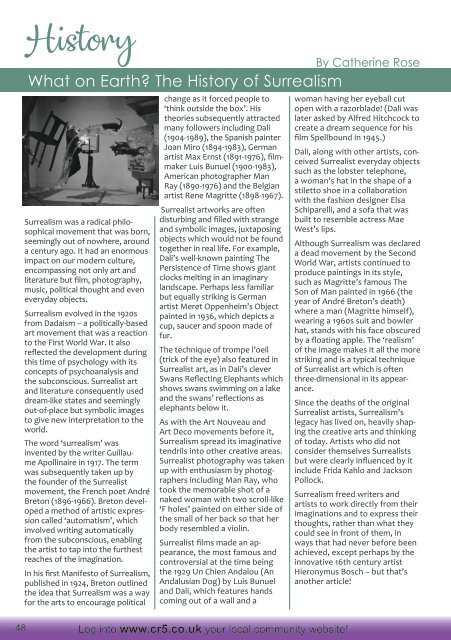CR5 Issue 159 August 2018
A local community magazine delivered free to 11,600 homes every month in the CR5 postcode. Contains local business advertising, interesting reads, What's on in the community and puzzles.
A local community magazine delivered free to 11,600 homes every month in the CR5 postcode. Contains local business advertising, interesting reads, What's on in the community and puzzles.
Create successful ePaper yourself
Turn your PDF publications into a flip-book with our unique Google optimized e-Paper software.
History<br />
What on Earth? The History of Surrealism<br />
Surrealism was a radical philosophical<br />
movement that was born,<br />
seemingly out of nowhere, around<br />
a century ago. It had an enormous<br />
impact on our modern culture,<br />
encompassing not only art and<br />
literature but film, photography,<br />
music, political thought and even<br />
everyday objects.<br />
Surrealism evolved in the 1920s<br />
from Dadaism – a politically-based<br />
art movement that was a reaction<br />
to the First World War. It also<br />
reflected the development during<br />
this time of psychology with its<br />
concepts of psychoanalysis and<br />
the subconscious. Surrealist art<br />
and literature consequently used<br />
dream-like states and seemingly<br />
out-of-place but symbolic images<br />
to give new interpretation to the<br />
world.<br />
The word ‘surrealism’ was<br />
invented by the writer Guillaume<br />
Apollinaire in 1917. The term<br />
was subsequently taken up by<br />
the founder of the Surrealist<br />
movement, the French poet André<br />
Breton (1896-1966). Breton developed<br />
a method of artistic expression<br />
called ‘automatism’, which<br />
involved writing automatically<br />
from the subconscious, enabling<br />
the artist to tap into the furthest<br />
reaches of the imagination.<br />
In his first Manifesto of Surrealism,<br />
published in 1924, Breton outlined<br />
the idea that Surrealism was a way<br />
for the arts to encourage political<br />
change as it forced people to<br />
‘think outside the box’. His<br />
theories subsequently attracted<br />
many followers including Dali<br />
(1904-1989), the Spanish painter<br />
Joan Miro (1894-1983), German<br />
artist Max Ernst (1891-1976), filmmaker<br />
Luis Bunuel (1900-1983),<br />
American photographer Man<br />
Ray (1890-1976) and the Belgian<br />
artist Rene Magritte (1898-1967).<br />
Surrealist artworks are often<br />
disturbing and filled with strange<br />
and symbolic images, juxtaposing<br />
objects which would not be found<br />
together in real life. For example,<br />
Dali’s well-known painting The<br />
Persistence of Time shows giant<br />
clocks melting in an imaginary<br />
landscape. Perhaps less familiar<br />
but equally striking is German<br />
artist Meret Oppenheim’s Object<br />
painted in 1936, which depicts a<br />
cup, saucer and spoon made of<br />
fur.<br />
The technique of trompe l’oeil<br />
(trick of the eye) also featured in<br />
Surrealist art, as in Dali’s clever<br />
Swans Reflecting Elephants which<br />
shows swans swimming on a lake<br />
and the swans’ reflections as<br />
elephants below it.<br />
As with the Art Nouveau and<br />
Art Deco movements before it,<br />
Surrealism spread its imaginative<br />
tendrils into other creative areas.<br />
Surrealist photography was taken<br />
up with enthusiasm by photographers<br />
including Man Ray, who<br />
took the memorable shot of a<br />
naked woman with two scroll-like<br />
‘F holes’ painted on either side of<br />
the small of her back so that her<br />
body resembled a violin.<br />
Surrealist films made an appearance,<br />
the most famous and<br />
controversial at the time being<br />
the 1929 Un Chien Andalou (An<br />
Andalusian Dog) by Luis Bunuel<br />
and Dali, which features hands<br />
coming out of a wall and a<br />
By Catherine Rose<br />
woman having her eyeball cut<br />
open with a razorblade! (Dali was<br />
later asked by Alfred Hitchcock to<br />
create a dream sequence for his<br />
film Spellbound in 1945.)<br />
Dali, along with other artists, conceived<br />
Surrealist everyday objects<br />
such as the lobster telephone,<br />
a woman’s hat in the shape of a<br />
stiletto shoe in a collaboration<br />
with the fashion designer Elsa<br />
Schiparelli, and a sofa that was<br />
built to resemble actress Mae<br />
West’s lips.<br />
Although Surrealism was declared<br />
a dead movement by the Second<br />
World War, artists continued to<br />
produce paintings in its style,<br />
such as Magritte’s famous The<br />
Son of Man painted in 1966 (the<br />
year of André Breton’s death)<br />
where a man (Magritte himself),<br />
wearing a 1960s suit and bowler<br />
hat, stands with his face obscured<br />
by a floating apple. The ‘realism’<br />
of the image makes it all the more<br />
striking and is a typical technique<br />
of Surrealist art which is often<br />
three-dimensional in its appearance.<br />
Since the deaths of the original<br />
Surrealist artists, Surrealism’s<br />
legacy has lived on, heavily shaping<br />
the creative arts and thinking<br />
of today. Artists who did not<br />
consider themselves Surrealists<br />
but were clearly influenced by it<br />
include Frida Kahlo and Jackson<br />
Pollock.<br />
Surrealism freed writers and<br />
artists to work directly from their<br />
imaginations and to express their<br />
thoughts, rather than what they<br />
could see in front of them, in<br />
ways that had never before been<br />
achieved, except perhaps by the<br />
innovative 16th century artist<br />
Hieronymus Bosch – but that’s<br />
another article!<br />
48 Log into www.cr5.co.uk your local community website!

















